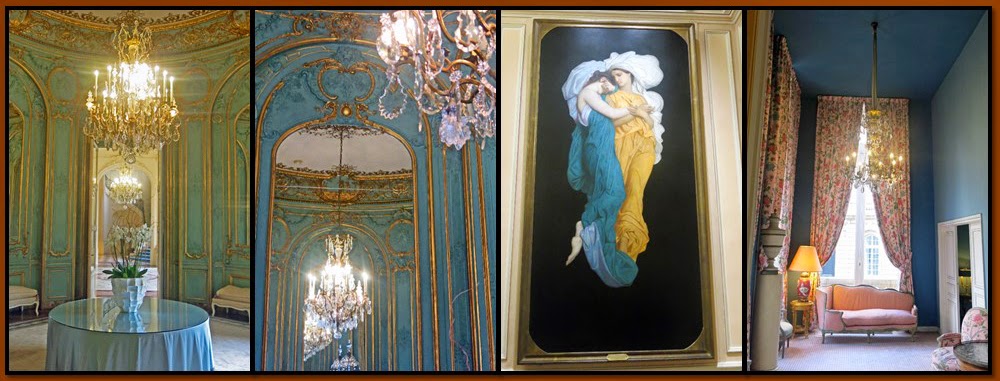I had the
opportunity to visit what now is the Residence of the U.S. Ambassador. The
present building has been preceded by others, but some major parts are from the
residence of the Baroness de Pontalba, built during the mid of the 19th
century, with Louis Visconti as architect.
(He’s of course also known for e.g. extensions of the Louvre and the
Luxembourg Palace (see previous posts), the Louvois Fountain (see previous
post), the Molière statue / fountain (see previous post), the Saint Sulpice
Fountain (see previous post)… and maybe especially for the tomb of Napoleon at
the Invalides (see previous post.)
I guess
some words must be said about the Baroness de Pontalba (1795-1874). She was
born in New Orleans, inherited very young an enormous fortune, got married,
also very young, to a Count Montalba, and came to live in France in the
Montalba castle Mont L’Evèque, some 40 km (25 miles) north-east of Paris. She
had some serious problems with the new relatively poor family wanting to get
hold of her fortune, more especially with the father-in- law, who actually shot
at her and injured her seriously, before committing suicide – which meant that
the Countess Pontalba became Baroness Pontalba. She later settled down in this
Paris building and lived there, officially separated from her husband, although
she took care of him during their latter part of life. The Baroness Pontalba is
also known for having created the Pontalba buildings around Jackson Square in
New Orleans – where you can also find the Saint John’s Cathedral built by her
father. (She returned to New Orleans for a short period in the 1840’s.) By the end of this post, you can find some
illustrations of her on a painting, when she was young and on a photo when she
was old, of the Mont l’Evèque castle, of the Pontalba buildings and the Jackson
Square.
The sons of
the Baroness sold the building to Baron E.J. de Rothschild in 1876, two years
after her death. Important modifications were then done to the building. During
WW II the building became an officers’ club for the Luftwaffe. After the war,
it was rented out to the British Royal Air Force Club and in 1948 it was rented
out and soon sold to the U.S. government, first used for offices, but since 1971
it has served as the official residence of the U.S. ambassador. Today the
recently nominated ambassador is Jane Hartley (you can see her portrait by the
end of the post).
Here we have at first a street view, rue du Faubourg Saint Honoré (see previous post), the
present façade, compared with what it looked like when the Baroness lived there
and before the Rothschild transformations...
... and from the interior, first some
views from the Entry Hall and its beautiful staircase … and statue of a woman
(I forgot the name of the artist).
Here we can
see the Octagonal Room and the nearby cloakroom with three paintings by William
Bouguereau (1825-1905).
The
Ballroom (equipped with all that is needed for movie projection…)
has its walls rather empty. Each ambassador brings new “decoration” and the
present ambassador, newly nominated, has not yet had the time. In the meantime,
you can admire some wooden sculpted scenes, based on La Fontaine fables.
In the
Pontalba Salon you can find the portrait of the Baroness and some wonderful
Chinese panels.
The
decoration of the Samuel Bernard Room had basically as origin the home of the banker
of Louis XV, restored, and is today furnished with a mixture of styles and
periods. The grand piano is of course a Steinway.
The Louis
XVI Room (see also top picture) serves sometimes also as a private dining room
for smaller parties. The table was set. (I was not invited.)
The State
Dining Room, used for important dinners and receptions, was quite empty for the
moment. Some remarkable Beauvais tapestries were to be seen.
All this is
to be found on the ground floor. Unfortunately the upper floors with the Jefferson
Library, the Presidential Bedroom, the Franklin Bedroom, the La Fayette
Bedroom, the Lindbergh Bedroom, the Private Dining Room, the Green Room and other
more private rooms could not be visited.
The large garden
has a number of exotic trees – American sequoias, Japanese maples…
As
mentioned above, here are at last some illustrations, in the order from above
left: The Baroness Pontalba in her younger years, in her older years, the Mont L’Evèque
Castle, the Jackson Square, the Pontalba buildings and a photo of the new
ambassador.















































































